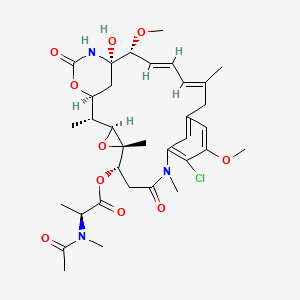| Liu Y et al. |
LC-MS/MS method for the simultaneous determination of Lys-MCC-DM1, MCC-DM1 and DM1 as potential intracellular catabolites of the antibody-drug conjugate trastuzumab emtansine (T-DM1). |
2017 |
J Pharm Biomed Anal |
pmid:28131055
|
| Bergamini A et al. |
Folate receptor alpha antagonists in preclinical and early stage clinical development for the treatment of epithelial ovarian cancer. |
2016 |
Expert Opin Investig Drugs |
pmid:27797594
|
| Zhong P et al. |
Glutathione-Sensitive Hyaluronic Acid-SS-Mertansine Prodrug with a High Drug Content: Facile Synthesis and Targeted Breast Tumor Therapy. |
2016 |
Biomacromolecules |
pmid:27723970
|
| Kashiwaba M et al. |
A multicenter Phase II study evaluating the efficacy, safety and pharmacokinetics of trastuzumab emtansine in Japanese patients with heavily pretreated HER2-positive locally recurrent or metastatic breast cancer. |
2016 |
Jpn. J. Clin. Oncol. |
pmid:26917603
|
| Squires H et al. |
Trastuzumab Emtansine for Treating HER2-Positive, Unresectable, Locally Advanced or Metastatic Breast Cancer After Treatment with Trastuzumab and a Taxane: An Evidence Review Group Perspective of a NICE Single Technology Appraisal. |
2016 |
Pharmacoeconomics |
pmid:26892972
|
| Jerjian TV et al. |
Antibody-Drug Conjugates: A Clinical Pharmacy Perspective on an Emerging Cancer Therapy. |
2016 |
Pharmacotherapy |
pmid:26799352
|
| Heudi O et al. |
Quantitative analysis of maytansinoid (DM1) in human serum by on-line solid phase extraction coupled with liquid chromatography tandem mass spectrometry - Method validation and its application to clinical samples. |
2016 |
J Pharm Biomed Anal |
pmid:26771131
|
| de Vries CL et al. |
Response of symptomatic brain metastases from HER-2 overexpressing breast cancer with T-DM1. |
2016 |
J. Neurooncol. |
pmid:26732082
|
| Elsada A et al. |
NICE guidance on trastuzumab emtansine for HER2-positive advanced breast cancer. |
2016 |
Lancet Oncol. |
pmid:26703893
|
| Luo Q et al. |
Structural Characterization of a Monoclonal Antibody-Maytansinoid Immunoconjugate. |
2016 |
Anal. Chem. |
pmid:26629796
|
| Gebhart G et al. |
Molecular imaging as a tool to investigate heterogeneity of advanced HER2-positive breast cancer and to predict patient outcome under trastuzumab emtansine (T-DM1): the ZEPHIR trial. |
2016 |
Ann. Oncol. |
pmid:26598545
|
| Walles M et al. |
New Insights in Tissue Distribution, Metabolism, and Excretion of [3H]-Labeled Antibody Maytansinoid Conjugates in Female Tumor-Bearing Nude Rats. |
2016 |
Drug Metab. Dispos. |
pmid:27122302
|
| Ogitani Y et al. |
DS-8201a, A Novel HER2-Targeting ADC with a Novel DNA Topoisomerase I Inhibitor, Demonstrates a Promising Antitumor Efficacy with Differentiation from T-DM1. |
2016 |
Clin. Cancer Res. |
pmid:27026201
|
| Baselga J et al. |
Relationship between Tumor Biomarkers and Efficacy in EMILIA, a Phase III Study of Trastuzumab Emtansine in HER2-Positive Metastatic Breast Cancer. |
2016 |
Clin. Cancer Res. |
pmid:26920887
|
| Force J et al. |
Nodular Regenerative Hyperplasia After Treatment With Trastuzumab Emtansine. |
2016 |
J. Clin. Oncol. |
pmid:24778392
|
| Ponte JF et al. |
Mirvetuximab Soravtansine (IMGN853), a Folate Receptor Alpha-Targeting Antibody-Drug Conjugate, Potentiates the Activity of Standard of Care Therapeutics in Ovarian Cancer Models. |
2016 |
Neoplasia |
pmid:27889646
|
| Hassan R et al. |
Mesothelin Immunotherapy for Cancer: Ready for Prime Time? |
2016 |
J. Clin. Oncol. |
pmid:27863199
|
| Kim SB et al. |
Relationship between tumor biomarkers and efficacy in TH3RESA, a phase III study of trastuzumab emtansine (T-DM1) vs. treatment of physician's choice in previously treated HER2-positive advanced breast cancer. |
2016 |
Int. J. Cancer |
pmid:27428671
|
| Mitsuya K et al. |
Expansive hematoma in delayed cerebral radiation necrosis in patients treated with T-DM1: a report of two cases. |
2016 |
BMC Cancer |
pmid:27377061
|
| Askoxylakis V et al. |
Preclinical Efficacy of Ado-trastuzumab Emtansine in the Brain Microenvironment. |
2016 |
J. Natl. Cancer Inst. |
pmid:26547932
|
